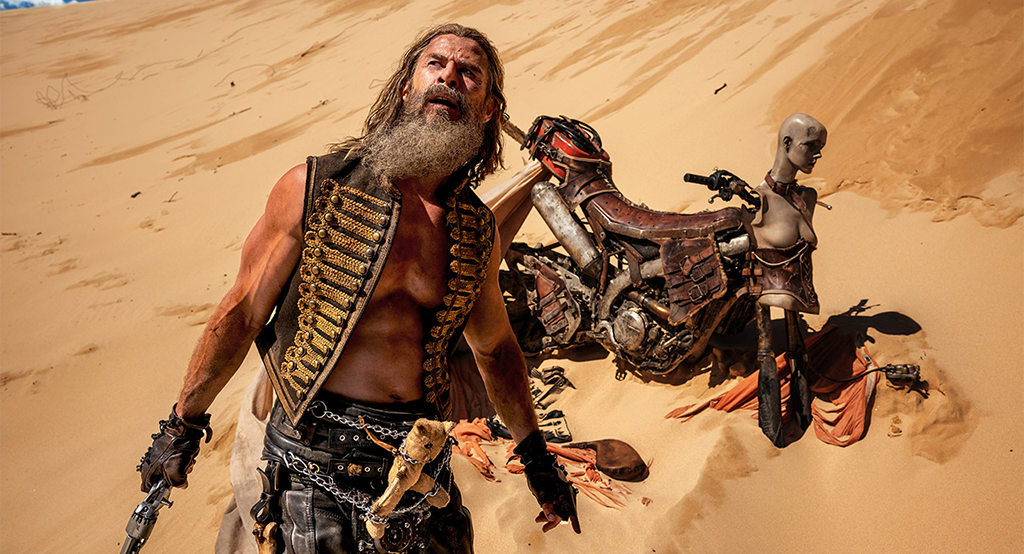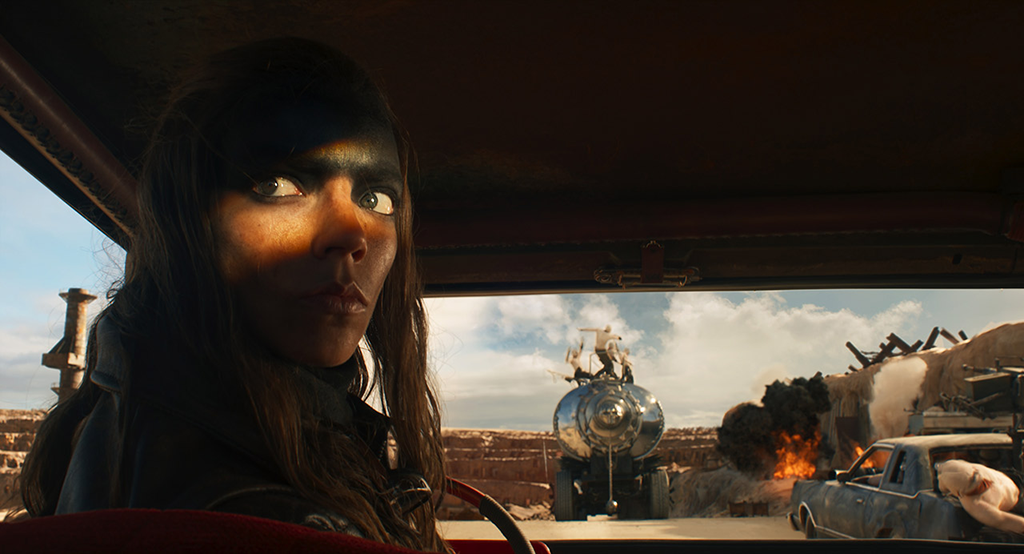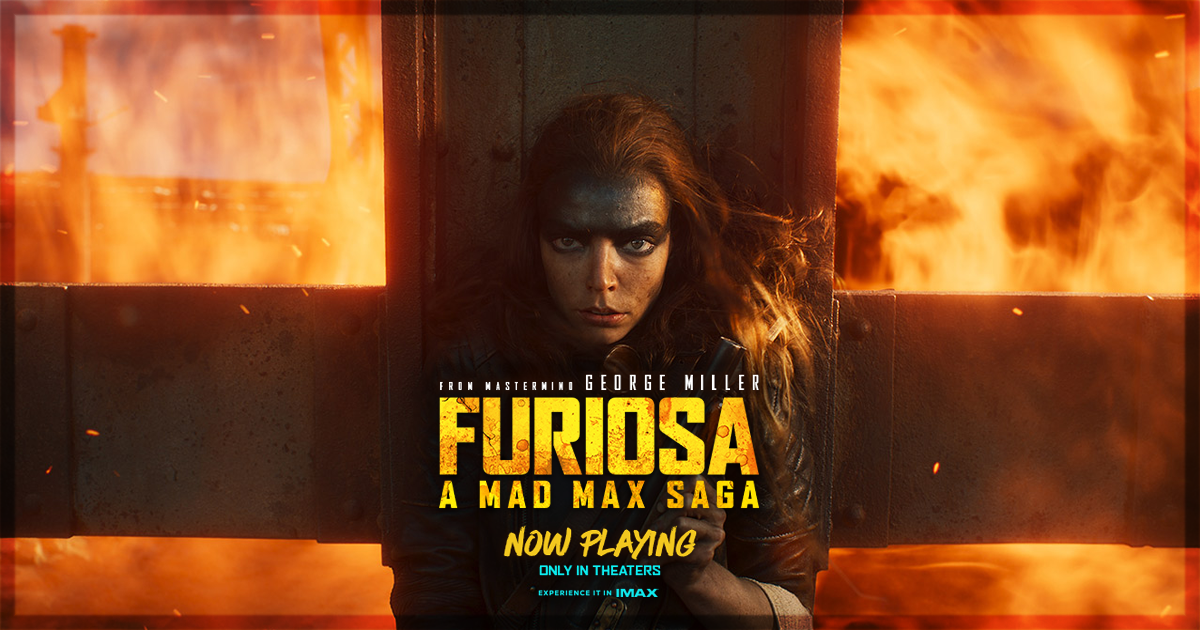What is the purpose of a prequel? You might say it is to further deepen the lore of a character, or to add context to the world that the prior film built. Perhaps it’s a supplement, a new adventure with fresh, exciting characters that feed into and enhance that next entry. Should it be its own standalone thing? One thing it must do, to this writer, is validate its existence and not depreciate whatever came before (or what will come after). It saddens me to feel that George Miller’s Furiosa: A Mad Max Saga doesn’t find enough of that merit; its over-explanation of lore and contextualization of the Furiosa character cheapening what makes the 2015 behemoth Mad Max: Fury Road such a feat of visual storytelling and enigmatic characterization.
[Editor’s Note: There are spoilers ahead for Furiosa: A Mad Max Saga.]
The story of Furiosa: A Mad Max Saga
The lush Green Place of Many Mothers opens Furiosa: A Mad Max Saga, as a young Furiosa (Alyla Browne) plucks a succulent fruit from a tree branch. To the world of fire and brimstone that the Mad Max movies inhabit, this is a paradise, an inverse of the Wasteland, this being a biblical Garden of Eden and the fruit that Furiosa picks as an emblem of the first sin. Fresh water, clean renewable energy and a contingent of people that are so-called ‘full life’ for their cleanliness, having been unsoiled by the harshness of the apocalypse. Heck, in our modern climate of energy barons hiking the prices up at the cost of vulnerable lives, this is a paradise in every universe.
This “place of abundance” is where young teen Furiosa is kidnapped from by a gang of wasteland thugs trying to win favour with their leader, Dementus (Chris Hemsworth), an animated psychopath who revels in the chaos of the wasteland. Mileage varies on how much Hemsworth’s performance as Dementus works – unsure as to the necessity or effectiveness of the prosthetic nose and chin – but Miller seems to have finally unlocked Hemsworth. Giving him a role that harnesses his Australian patois, Hemsworth infuses the comedic sensibilities he showed in Thor with an affable sense of chaos energy as he rides his three-abreast motorcycle chariot while a toy bear, that once belonged to his deceased children, hangs loose to his groin, bouncing at the lurch of chariot wheels going over human skulls.

Dementus takes Furiosa under his wing after murdering Furiosa’s mother (a scene-stealing Charlee Fraser) in a way that is reconstructing the father dynamic lost to him. But this isn’t anywhere near the loving relationship you’d expect of a man clinging to the faint memory of his children. Furiosa, a “full-life,” is but a bargaining chip for power. After close to 45 minutes of what is basically a prologue within this exuberant, indulgent foray, Furiosa is taken by Immortan Joe (Lachy Hulme, after the passing of Hugh Keays-Byrne) and placed in a position to become one of his wives.
As we know from Fury Road, the wives are solely there to breed and produce ‘mothers milk’ in this parched land that is fuelled by bullets and gasoline. But Furiosa escapes the grubby clutches of Joe’s sons, Rictus (Nathan Jones) and Scrotus (Josh Helman), and 15 years pass. Furiosa (now Anya Taylor-Joy) attempts to escape the horrors of Immortan Joe’s society by infiltrating the citadel as a mute boy, all while plotting revenge against Dementus.
A closer look at Furiosa in Furiosa: A Mad Max Saga
This summary of the film’s plot covers roughly the first hour of the film and sums up a lot of the issues surrounding Furiosa and the choices Miller makes. The film, which spans 2 hours and 28 minutes, chooses where to drop us into the story poorly. For instance, the fifteen years that pass are thrown to the wind – though the time-passing effect employed is rather stunning – and so we have next to no understanding of what Furiosa has gone through to assimilate into the impoverished culture, how she survived going through puberty as a teenage girl while trying to hide her gender and full-life status from the elite. What relationships did she make to survive years under the oppressive rule of Immortan Joe? What specific quirks of the culture did she have to learn in this span of fifteen years to survive?
The bargaining chip that just cost Joe the settlement of Gastown to the economically-minded Dementus has run off, but nobody seems to care in this citadel that Furiosa has vanished, with no search party released. The time jump indicates no growth in Furiosa’s character or in the structures of Joe’s family dynamic. We’re expected to believe that the young girl who escaped the clutches of forced marriage hasn’t changed, or tried to escape by other means, or has even been searched for by the maniacal dictator.

This could be shrugged off as a character trait. Furiosa, as we know from Fury Road, is a resilient, stoic warrior, so not changing in fifteen years might be the point, as her revenge fuels her inability to make connections or incite any mental or personal changes. But this isn’t the only instance that time jumps are made in this sprawling, revenge odyssey. After returning to the citadel, Furiosa stows away under the War Rig – a giant beast of a machine that is central in most actions sequences, its metallic claw-machine limbs snatching and swinging away at Dementus’ horde being an action highlight – before being caught up in a battle along fury road.
Saving the rig and the life of Praetorian Jack (Tom Burke), an apathetic rig driver cited as the best the fury road has ever seen, she joins up with him on his deliveries back and forth from the Bullet Farm and the now Dementus-owned GasTown. He shows Furiosa kindness, perhaps the only time she has ever been shown as such since leaving home, and states he will train her shall she help reunite him with a capable crew.
It is almost a direct jumpcut into Jack and Furiosa parting ways, their time spent together relegated to the script’s cutting room floor. But the two have apparently bonded, and a big action beat – extremely hesitant to call this an emotional beat – is based on how important Jack has become to her. Miller has no interest in relationships or what could be perceived as love, and it makes this film completely fluff any emotional attachment we’re supposed to have. Furiosa’s ideas around childhood and innocence lost play into the feminist ideals and pro-choice subtext of Fury Road, and by all intents and purposes, this should be ripe with emotion.
The post-apocalyptic world that Furiosa inhabits is frenzied with rage, but for all the bullets that get fired, not a single one is fired with emotion, or with any resonant truth about the characters. Instead, it becomes a laborious chore, a beautiful spectacle with a frustratingly hollow core in place of what should be a deep well of emotion. The moments that do elicit emotion are few and far between; a character called The History Man, an elder with history tattooed in a scrawl on his body, and a young War Boy (Quaden Bayles) – a faction of Immortan Joe’s military, ready to lay down their lives for their deity for the chance to get to heaven – get their moments but it’s too shallow to let this emotion breathe.
As lukewarm as one is to Fury Road, the craft of Miller and crew demand respect. Fury Road blended its environment with use of CGI, practical effects, and digital coming together in gorgeous harmony. Quite how a film that was released nine years earlier to Furiosa looked so ravishing is still a mystery (note to self: must read that copy of Blood, Sweat and Chrome gathering dust), but as often as Furiosa is stunning, capturing the archaic harshness of this universe, there are too many visual interruptions with noticeable use of digital effects. Furiosa demands the same respect as Fury Road for its undeniable craft, but for what should be an experience undisturbed by the seams, it too often stalls because of this.
But what is most irksome about Furiosa, and really shouldn’t be given a lack of vested interest in the franchise, is that this prequel undermines Fury Road. The presentation of Furiosa in Fury Road is that she is an enigma. Miller’s careful decisions in how he slowly unraveled her as a character are what made Furiosa one of the most iconic action heroes of the 21st century. In Furiosa, her mystery is re-unraveled as the film works to contextualize the elements that we already gleaned from the lean, frugal characterization.
For what purpose does showing how Furiosa lost her arm serve? It demystifies the character of Furiosa. While not as particularly egregious as the infamous scene in Solo, where we learn how the rugged space cowboy in Star Wars got his name, it feels like a symptom of modern audiences’ relationship with media, where there is an unnecessary desperation for more knowledge on these characters, even at the detriment of what makes the characters so popular.
Furiosa is so often beautifully composed, and its action sequences are kinetic, filled with a wide-eyed mania that is hard to resist, but Miller is pushing away audiences who require their art to be less emotionally vacant. It is impossible not to be awed by the sheer audacity of Miller, who provides action of a quality not often seen on this scale, but the narrative skeleton is too flimsy for a film this sprawling, and Miller chooses to avoid anything emotional or thematically tangible. There is a flicker of a discussion on socio-economics, with Dementus’ capture and subsequent failure to maintain Gastown, but it’s far too brief for being the only time Furiosa feels like it’s attempting to provoke something more thoughtful than carnage for carnage’s sake.
Furiosa: A Mad Max Saga retreads familiar ground about Furiosa
The adage “it’s the journey, not the destination” is often cited around prequels as a way to foreshadow the criticism that if you know the destination, the outcome of the journey is predetermined. But this can only work with the subversion of assumed ideas. There is no subversion to the character of Furiosa from what we already understand from her appearance in Fury Road – Miller even frustratingly refuses a pronounced denouement for Furiosa.
We know she came from a luscious land of many mothers, we know she has a prosthetic arm, we know she sports a buzzcut. The information that we gather about Furiosa during the film is everything we already understood about the character. Thus, the entire film is mostly just a grueling 2-hour and 28-minute spectacle, finding itself working only as a grand explosion of reiterated exposition about Furiosa. The journey in this prequel may be ravishing to behold, but this is auto-pilot storytelling that serves to fill in narrative gaps no one ever needed filled in.
Furiosa: A Mad Max Saga is now playing in theaters.
Learn more about the film, including how to get tickets, at the official website.
You might also like…
‘All That We Love’ Movie Review: A Tender Look at Grief, Family, and Healing


